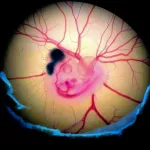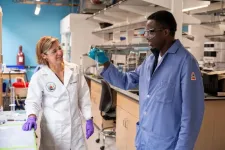(Press-News.org) To find the cause of the "dessert stomach", the researchers investigated the reaction of mice to sugar and found that completely satiated mice still ate desserts. Investigations of the brain showed that a group of nerve cells, the so-called POMC neurones, are responsible for this. These neurones become active as soon as the mice were given access to sugar which facilitated their appetite.
When mice are full and eat sugar, these nerve cells not only release signaling molecues that stimulate satiety, but also one of the body's own opiate: ß-endorphin. This acts on other nerve cells with opiate receptors and triggers a feeling of reward, that causes the mice to eat sugar even beyond fullness. This opioid pathway in the brain was specifically activated when the mice ate additional sugar, but not when they ate normal or fatty food. When the researchers blocked this pathway, the mice refrained from eating additional sugar. This effect was only observed in full animals. In hungry mice, the inhibition of ß-endorphin release had no effect.
Interestingly, this mechanism was already activated when the mice perceived the sugar before eating it. In addition, the opiate was also released in the brains of mice that had never eaten sugar before. As soon as the first sugar solution entered the mice's mouths, ß-endorphin was released in the "dessert stomach region", which was further strengthened by additional sugar consumption.
What happens in humans?
The scientists also carried out brain scans on volunteers who received a sugar solution through a tube. They found that the same region of the brain reacted to the sugar in humans. In this region, as in mice, there are many opiate receptors close to satiety neurons.
"From an evolutionary perspective, this makes sense: sugar is rare in nature, but provides quick energy. The brain is programmed to control the intake of sugar whenever it is available," explains Henning Fenselau, research group leader at the Max Planck Institute for Metabolism Research and head of the study.
Relevance for the treatment of obesity
The research group's findings could also be important for the treatment of obesity. "There are already drugs that block opiate receptors in the brain, but the weight loss is less than with appetite-suppressant injections. We believe that a combination with them or with other therapies could be very useful. However, we need to investigate this further," says Fenselau.
END
Dessert stomach emerges in the brain
Nerve cells that tell to us we are full also make us crave sweets
2025-02-13
ELSE PRESS RELEASES FROM THIS DATE:
Fungus ‘hacks’ natural immune system causing neurodegeneration in fruit flies
2025-02-13
A fungal infection has been shown to trigger a fruit fly’s own immune system to destroy brain cells leading to signs of neurodegeneration, a new study has found.
The paper published in PLOS Biology today found that a fungus called Beauveria bassiana was able to make the fly’s innate immune system trigger a process that kills neurons and glia in the brain, leading to more than half of flies dying after seven days compared to half of control samples living for nearly 50 days.
In experiments conducted by a team of academics from the University of ...
A new view on 300 million years of brain evolution
2025-02-13
Leuven, 14 February 2025 – In a new study published in Science, a Belgian research team explores how genetic switches controlling gene activity define brain cell types across species. They trained deep learning models on human, mouse, and chicken brain data and found that while some cell types are highly conserved between birds and mammals after millions of years of evolution, others have evolved differently. The findings not only shed new light on brain evolution; they also provide powerful tools for studying how gene regulation shapes different cell types, across species or different disease states.
Our brain, and by extension ...
Birds have developed complex brains independently from mammals
2025-02-13
The pallium is the brain region where the neocortex forms in mammals, the part responsible for cognitive and complex functions that most distinguishes humans from other species. The pallium has traditionally been considered a comparable structure among mammals, birds, and reptiles, varying only in complexity levels. It was assumed that this region housed similar neuronal types, with equivalent circuits for sensory and cognitive processing. Previous studies had identified the presence of shared excitatory and inhibitory neurons, as well as general connectivity patterns suggesting a similar evolutionary path in these ...
Protected habitats aren’t enough to save endangered mammals, MSU researchers find
2025-02-13
Images
EAST LANSING, Mich. – Tropical forests are massive biodiversity storehouses. While these rich swathes of land constitute less than one-tenth of Earth’s surface, they harbor more than 60% of known species. Among them is a higher concentration of endangered species than anywhere else on Earth.
However, these regions are also under immense pressure, as tropical land is rapidly being transformed for industrial and agricultural purposes.
Worldwide, regional governments and international groups are establishing new protected areas to slow further loss of threatened species. However, new research appearing in the journal PLOS Biology demonstrates ...
Scientists find new biomarker that predicts cancer aggressiveness
2025-02-13
HOUSTON ― Using a new technology and computational method, researchers from Fred Hutch Cancer Center and The University of Texas MD Anderson Cancer Center have uncovered a biomarker capable of accurately predicting outcomes in meningioma brain tumors and breast cancers.
In the study, published today in Science, the researchers discovered that the amount of a specific enzyme, RNA Polymerase II (RNAPII), found on histone genes was associated with tumor aggressiveness and recurrence. Hyper-elevated levels of RNAPII on these histone genes indicate cancer over-proliferation and potentially contribute to chromosomal changes. These findings point to the use of a new genomic technology as ...
UC Irvine astronomers gauge livability of exoplanets orbiting white dwarf stars
2025-02-13
Irvine, Calif., Feb. 13, 2025 — Among the roughly 10 billion white dwarf stars in the Milky Way galaxy, a greater number than previously expected could provide a stellar environment hospitable to life-supporting exoplanets, according to astronomers at the University of California, Irvine.
In a paper published recently in The Astrophysical Journal, a research team led by Aomawa Shields, UC Irvine associate professor of physics and astronomy, share the results of a study comparing the climates of exoplanets at two different stars. One is a hypothetical white dwarf that’s passed through much of its life cycle and is on a slow path ...
Child with rare epileptic disorder receives long-awaited diagnosis
2025-02-13
Researchers at Baylor College of Medicine, the Jan and Dan Duncan Neurological Research Institute (Duncan NRI) at Texas Children's Hospital, Baylor Genetics and collaborating institutions provided a long-awaited and rare genetic diagnosis in a child with Lennox-Gastaut syndrome, a type of developmental epileptic encephalopathy (DEE), associated with a severe, complex form of epilepsy and developmental delay.
Their recent study reports that a highly complex rearrangement of fragments from chromosomes 3 and 5 altered the typical organization of genes in the q14.3 region of chromosome ...
WashU to develop new tools for detecting chemical warfare agent
2025-02-13
Mustard gas, also known as sulfur mustard, is one of the most harmful chemical warfare agents, causing blistering of the skin and mucous membranes on contact. Chemists at Washington University in St. Louis have been awarded a $1 million contract with the Defense Threat Reduction Agency (DTRA) to develop a new way to detect the presence of this chemical weapon on the battlefield.
As with many chemical threats, quick identification of sulfur mustard is key to minimizing its damage, according to Jennifer Heemstra, the Charles Allen Thomas Professor of Chemistry in Arts & Sciences and principal investigator of the new DTRA grant.
“It’s ...
Tufts researchers discover how experiences influence future behavior
2025-02-13
Neuroscientists have new insights into why previous experiences influence future behaviors. Experiments in mice reveal that personal history, especially stressful events, influences how the brain processes whether something is positive or negative. These calculations ultimately impact how motivated a rodent is to seek social interaction or other kinds of rewards.
In a first of its kind study, Tufts University School of Medicine researchers demonstrate that interfering with the neural circuits responsible ...
Engineers discover key barrier to longer-lasting batteries
2025-02-13
Lithium nickel oxide (LiNiO2) has emerged as a potential new material to power next-generation, longer-lasting lithium-ion batteries. Commercialization of the material, however, has stalled because it degrades after repeated charging.
University of Texas at Dallas researchers have discovered why LiNiO2 batteries break down, and they are testing a solution that could remove a key barrier to widespread use of the material. They published their findings online Dec. 10 in the journal Advanced Energy Materials.
The team plans first to manufacture LiNiO2 batteries in the lab and ...
LAST 30 PRESS RELEASES:
Making lighter work of calculating fluid and heat flow
Normalizing blood sugar can halve heart attack risk
Lowering blood sugar cuts heart attack risk in people with prediabetes
Study links genetic variants to risk of blinding eye disease in premature infants
Non-opioid ‘pain sponge’ therapy halts cartilage degeneration and relieves chronic pain
AI can pick up cultural values by mimicking how kids learn
China’s ecological redlines offer fast track to 30 x 30 global conservation goal
Invisible indoor threats: emerging household contaminants and their growing risks to human health
Adding antibody treatment to chemo boosts outcomes for children with rare cancer
Germline pathogenic variants among women without a history of breast cancer
Tanning beds triple melanoma risk, potentially causing broad DNA damage
Unique bond identified as key to viral infection speed
Indoor tanning makes youthful skin much older on a genetic level
Mouse model sheds new light on the causes and potential solutions to human GI problems linked to muscular dystrophy
The Journal of Nuclear Medicine ahead-of-print tip sheet: December 12, 2025
Smarter tools for peering into the microscopic world
Applications open for funding to conduct research in the Kinsey Institute archives
Global measure underestimates the severity of food insecurity
Child survivors of critical illness are missing out on timely follow up care
Risk-based vs annual breast cancer screening / the WISDOM randomized clinical trial
University of Toronto launches Electric Vehicle Innovation Ontario to accelerate advanced EV technologies and build Canada’s innovation advantage
Early relapse predicts poor outcomes in aggressive blood cancer
American College of Lifestyle Medicine applauds two CMS models aligned with lifestyle medicine practice and reimbursement
Clinical trial finds cannabis use not a barrier to quitting nicotine vaping
Supplemental nutrition assistance program policies and food insecurity
Switching immune cells to “night mode” could limit damage after a heart attack, study suggests
URI-based Global RIghts Project report spotlights continued troubling trends in worldwide inhumane treatment
Neutrophils are less aggressive at night, explaining why nighttime heart attacks cause less damage than daytime events
Menopausal hormone therapy may not pose breast cancer risk for women with BRCA mutations
Mobile health tool may improve quality of life for adolescent and young adult breast cancer survivors
[Press-News.org] Dessert stomach emerges in the brainNerve cells that tell to us we are full also make us crave sweets



